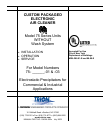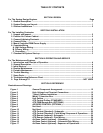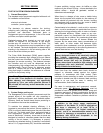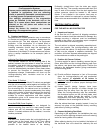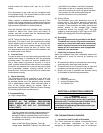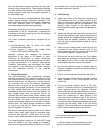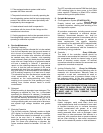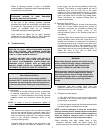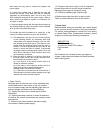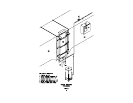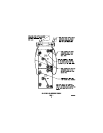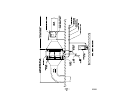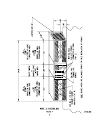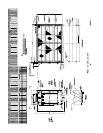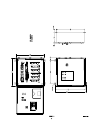
3
sloped toward the cabinet drain pan for an 18-inch
length.
Duct securement to the collar may be completed using
the predrilled flange. The seam should be made air and
watertight by caulking or gasketing.
When a blower is installed downstream from the Trion
cabinet, the ducting between the cabinet and the blower
will be under negative pressure and should be made air
tight to prevent infiltration of contaminated air.
After the ductwork has been installed, clear remaining
material or debris from inside ducts and bottom of
cabinet, and then re-install both the mechanical filters
and the ionizing-collecting cells.
NOTE: Follow the directional arrows located on the cell
end plates. The side of each cell containing the spiked
ionizer blades must be located on the air entering side
of the cabinet. The brass contact plungers on the cell
should be inserted toward the back of cabinet. Also,
mist suppressors when specified must be located on the
air entering side of the cabinet.
4. Connect Drain
Connect a drain line to the pipe coupling provided in the
cabinet drain basin in accordance with the governing
plumbing codes. The drain line must be sealed with a
trap or other means to prevent air by pass. If a trap is
used, it should hold sufficient water column to overcome
the system air pressure and to assure that loss of liquid
from evaporation between cleaning periods will not
break the seal. The drain line should not be smaller than
the drainpipe coupling.
5. Mount Controller
The Controller should be mounted at eye level and
located as close to the air cleaner as practical. It must
be mounted indoors out of the weather unless supplied
with a weatherproof cabinet. Allow sufficient space in
front of the access door(s) for service. Refer to
appropriate Control/Remote PWM Box Outline Drawing
for mounting hole layout and dimensions.
6. Complete Wiring
(a). High Voltage Wiring
WARNING:
EXERCISE ALL THE NORMAL PRECAUTIONS
WHEN WORKING WITH HIGH VOLTAGE AND
COMPLY WITH NEC AND ALL APPROPRIATE
LOCAL CODES.
The high voltage wiring entails interconnecting the
power supply(s) to the ionizing-collecting cell(s)
through the factory-installed junction box on top of
the cabinet. All the wiring in the cabinet has been
completed at the factory.
Refer to the Field Wiring Diagram. Two high
voltage leads, Red/Black Tracer for the ionizer and
one Red for the collector, are factory furnished.
Each lead is to be run in separate conduit and
must be of continuous run (do not splice) between
the controller and the ionizing-collecting cell
terminal connection in the junction box.
(b). Primary Wiring
The Controller is the main distribution point for all
primary wiring. The various electrical components
involved are connected to and powered from the
controller. These interlocks are safety switches that
prevent access to the charged high voltage
components without first turning “OFF” the high
voltage by interrupting the 24 VDC input to the PLC.
Refer to the appropriate Field Wiring Diagram.
(c). Grounding
An earth ground must be provided to the Model
75 cabinet and control. All ground connections
must be in contact with bare metal and securely
affixed. Ground conductor size and connection
means will be in accordance with all applicable
electrical code standards.
7. Check Out for System Start-up
When the installation has been completed, assure that
the equipment is ready for start-up by checking the
following:
A. All construction debris is removed from the ionizing-
collecting cells, drain basin and ductwork.
B. The drain line from the Trion drain basin is clear and
completely connected to its point of termination.
C. Supply line power is available and electrical wiring
is completed to the following components:
1. Controller
2. Electrical Interlocks
3. Ionizing-Collecting Cells
4. The System Fan
SECTION III OPERATION & SERVICE
WARNING
RISK OF ELECTRIC SHOCK
These serving instructions are for use by qualified
personnel only. To reduce the risk of electric shock,
do not perform any servicing other than that
contained in the operating instructions unless you
are qualified to do so.
FOR THE MAINTENANCE ENGINEER
1. Introduction and Principle of Operation
The Trion electronic air cleaner is technically known
as an electrostatic precipitator. In this type of
equipment, all airborne particles, even of microscopic



